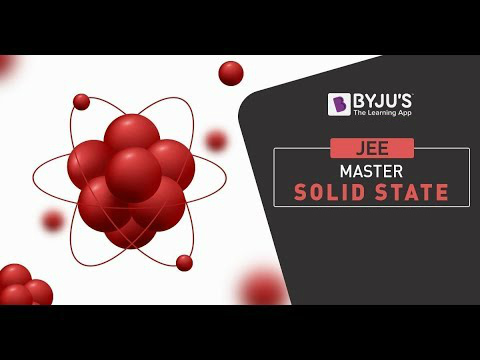Solid-state is one of the states of matter. In our early days of schooling, we have learnt that matter exists in three states – solid, liquid and gas. However, as we progress from lower to higher classes, the concepts get more advanced, and there are more things to learn. In this lesson, we will be dealing with the concept of solid-state in a broader aspect and understand all the underlying terms, including the properties as well as the types of solids.
Download Complete Chapter Notes of The Solid State
Download Now
Solids generally exhibit certain characteristics that set them apart from liquids and gases. For example, they have the ability to resist any force that is applied to its surface. However, the solid-state of compounds largely depends on the properties of atoms, such as their arrangement and the forces acting between them.
Table of Contents
- Physical and Chemical Properties of Solids
- Solid State Chemistry
- Types of Solid States
- Crystalline Solid State
- Amorphous Solid State
Physical and Chemical Properties of Solids
- Solids are incompressible, which means the constituent particle is arranged close to each other and because of that, there is negligible space between the constituent particle.
- Solids are rigid. This is due to the lack of space between the constituent particles, which makes it rigid or fixed.
- Solids have definite mass, volume and shape, due to which it has a compact arrangement of constituent particles.
- The intermolecular distance between molecules is short. Due to this, the force between the constituent particles (atoms, molecules or ions) is very strong.
- The constituents particles can only oscillate about their mean positions.
Also Read: Defects in Solids
Solid State Chemistry
Solid-state in Chemistry is the study of the structure, properties and synthesis of solid materials. It is also sometimes called materials chemistry. More significantly, in solid-state chemistry, we study the concept of a compound on a deeper level. It basically helps us understand the compound from a molecular level to a crystal structure level.
In solid-state chemistry, nonstoichiometric compounds are categorised as exclusive solid-state compounds due to their structure and thermodynamic characteristics.
Types of Solid States
Based on the arrangement of constituent particles, solids are classified into two-state types:
- Crystalline Solids
- Amorphous Solids
Crystalline Solid State
Crystalline solids are those that have a typical geometry. In such types of solids, there are definite arrangements of particles (atoms, molecules or ions ) throughout the 3-dimensional network of a crystal in a long-range order. Examples include Sodium Chloride, Quartz, Diamond, etc.
Properties of Crystalline Solids
- Crystalline solids have a sharp melting point and start melting when it reaches a particular temperature.
- The shape of crystalline solids is definite and has typical arrangements of particles.
- They show cleavage property, i.e., when they are cut with the edge of a sharp tool, they split into two pieces, and the newly generated surfaces are smooth and plain.
- They have definite heat of fusion (amount of energy needed to melt a given mass of solid at its melting point).
- Crystalline solids are anisotropic, which means their physical properties, like electrical resistance or refractive index, show different values when they are measured along with different directions in the same crystal.
- Crystalline solids are true solids.
Types of Crystalline Solids
On the basis of the nature of intermolecular forces or chemical bonding, crystalline solids are further classified into four categories. They are as follows:
- Molecular solids
- Ionic solids
- Metallic solids
- Covalent solids
Molecular Solids
In molecular solids, the constituent particles are molecules. They are further divided into three categories:
1. Non-polar Molecular Solids
These solids are formed from molecules or atoms that share a non-polar covalent bond. The atoms or molecules are held by weak dispersion force or by London forces.
- The physical nature of non-polar solids is soft.
- They don’t conduct electricity, so they are insulators.
- They have a very low melting point.
- Examples: H2, Cl2, I2 etc.
2. Polar Molecular Solids
- These solids are held together by polar covalent bonds, and the atoms/molecules are bonded by relatively stronger dipole-dipole interactions.
- The physical nature is soft, and most of these are gases or liquids at room temperature.
- They do not conduct electricity, and they have a higher melting point than non-polar molecular solids.
- Examples: HCl, SO2, NH3, etc.
3. Hydrogen-bonded Molecular Solids
The solids contain polar covalent bonds with Hydrogen, Fluorine, Oxygen and Nitrogen atoms. In these solids, molecules are held together via strong hydrogen bonding.
- The physical nature of such solids is hard.
- They do not conduct electricity.
- The physical state of these solids is volatile liquids or soft solids under room temperature.
- They have a low melting point.
- Example: H2O (Ice ).
Ionic Solids
In ionic solids, the constituent particles are ions. These are formed by the arrangement of cations and anions by strong Coulombic forces.
- These are hard and brittle in nature.
- Ionic solids act as an insulator in a solid-state but are conductors in a molten and aqueous state.
- They have a high melting point.
- Examples: NaCl, MgO, ZnS, CaF2 etc.
Metallic Solids
- Positive metal ions in a sea of delocalised electrons. These electrons are evenly spread out throughout the crystal.
- Due to the presence of free and mobile electrons, they are responsible for high electrical and thermal conductivity.
- They are conductors in both solid and molten states.
- The physical nature of these solids is hard, but they are malleable and ductile.
- They have high melting point than ionic solids.
- Examples: Fe, Cu, Ag, Mg, etc.
Covalent or Network Solids
A wide range of crystalline solids of non-metal form covalent bonds between adjacent atoms throughout the crystal and form giant molecules or large molecules.
- These solids are hard, like diamond and soft, like graphite which are isotopes of carbon.
- They are insulators, as in the case of a diamond, but in the case of graphite, due to free electrons, they conduct electricity and act as a conductor.
Amorphous Solid State
Amorphous solid-state comprises those solids which have the property of rigidity and incompressibility but to a certain extent. They do not have a definite geometrical form or long range of order. Examples include glass, rubber, plastic, etc.
Properties of Amorphous Solids
- Amorphous solids are gradually softened over a range of temperatures, and they can be moulded into different shapes on heating.
- Amorphous solids are pseudo-solids or supercooled liquids, which means they have a tendency to flow very slowly. If you observe the glass pans, which are fixed to windows of old buildings, they are found to be slightly thicker from the bottom than at the top.
- Amorphous solids have irregular shapes. i.e., their constituent particles do not have definite geometry of arrangements.
- When amorphous solids are cut with a sharp edge tool, they form pieces with irregular surfaces.
- Amorphous solids do not have definite heat of fusion due to the irregular arrangement of the particles.
- Amorphous solids are isotropic in nature, which means the value of any physical property would be the same along any direction because of the irregular arrangement of particles.
Amorphous Solids Uses
Amorphous silicon, which is one of the best photovoltaic materials, converts sunlight into electricity.
Recommended Videos
Solid State Notes and Questions

Solid State Class 12 One-Shot Full Chapter Revision for JEE Main 2022

Solid State – Types of Unit Cells

Solid State Important JEE Questions and Answers

Solid State – Video Lesson

Solids and Unit Cells – JEE Concepts

Solid State – Voids in FCC and HCP

Solid State – Top 10 Most Important JEE Main Questions


Comments